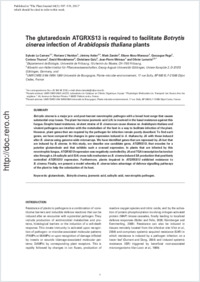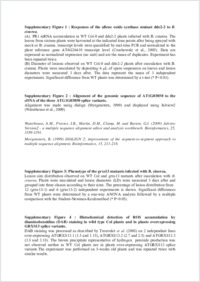The glutaredoxin ATGRXS13 is required to facilitate Botrytis cinerea infection of Arabidopsis thaliana plants
- Camera, Sylvain La Département de Biologie, Université de Fribourg, Switzerland
- L'Haridon, Floriane Département de Biologie, Université de Fribourg, Switzerland
- Astier, Jérémy Département de Biologie, Université de Fribourg, Switzerland
- Zander, Mark Albrecht-von-Haller-Institut für Pflanzenwissenschaften, Georg-August-Universität Göttingen, Germany
- Abou-Mansour, Eliane Département de Biologie, Université de Fribourg, Switzerland
- Page, Gonzague Département de Biologie, Université de Fribourg, Switzerland
- Thurow, Corinna Albrecht-von-Haller-Institut für Pflanzenwissenschaften, Georg-August-Universität Göttingen, Germany
- Wendehenne, David UMR CNRS 5184 INRA 1088 Université de Bourgogne, Dijon, France
- Gatz, Christiane Albrecht-von-Haller-Institut für Pflanzenwissenschaften, Georg-August-Universität Göttingen, Germany
- Métraux, Jean-Pierre Département de Biologie, Université de Fribourg, Switzerland
- Lamotte, Olivier Département de Biologie, Université de Fribourg, Switzerland - UMR CNRS 5184 INRA 1088 Université de Bourgogne, Dijon, France
-
31.08.2011
Published in:
- The Plant Journal. - 2011, vol. 68, no. 3, p. 507–519
English
Botrytis cinerea is a major pre- and post-harvest necrotrophic pathogen with a broad host range that causes substantial crop losses. The plant hormone jasmonic acid (JA) is involved in the basal resistance against this fungus. Despite basal resistance, virulent strains of B. cinerea can cause disease on Arabidopsis thaliana and virulent pathogens can interfere with the metabolism of the host in a way to facilitate infection of the plant. However, plant genes that are required by the pathogen for infection remain poorly described. To find such genes, we have compared the changes in gene expression induced in A. thaliana by JA with those induced after B. cinerea using genome-wide microarrays. We have identified genes that are repressed by JA but that are induced by B. cinerea. In this study, we describe one candidate gene, ATGRXS13, that encodes for a putative glutaredoxin and that exhibits such a crossed expression. In plants that are infected by this necrotrophic fungus, ATGRXS13 expression was negatively controlled by JA and TGA transcription factors but also through a JA-salicylic acid (SA) cross-talk mechanism as B. cinerea induced SA production that positively controlled ATGRXS13 expression. Furthermore, plants impaired in ATGRXS13 exhibited resistance to B. cinerea. Finally, we present a model whereby B. cinerea takes advantage of defence signalling pathways of the plant to help the colonization of its host.
- Faculty
- Faculté des sciences et de médecine
- Department
- Département de Biologie
- Language
-
- English
- Classification
- Biological sciences
- License
-
License undefined
- Identifiers
-
- RERO DOC 27897
- DOI 10.1111/j.1365-313X.2011.04706.x
- Persistent URL
- https://folia.unifr.ch/unifr/documents/302144
Other files
Statistics
Document views: 168
File downloads:
- pdf: 340
- Supplementary material: 162

